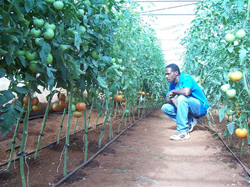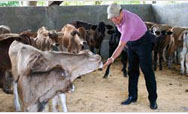You are here » Home » Telling Our Story
Case Study
Farmers learn to build low-cost greenhouses and boost profits
Greenhouses Increase Crop Yields

| |
Photo: Fintrac
|
|
Jervis Rowe of Jamaica inspects his tomato plants grown within a USAID-provided greenhouse in Manchester, Jamaica.
“I can now grow vine ripe tomatoes, which have a better flavor and appearance ... We are actually producing crops that are better in quality than those we import,” said Jervis Rowe of Manchester, Jamaica. He is one of the farmers benefitting from the new greenhouse technology.
|
Challenge
Situated in the heart of the hurricane zone, the Caribbean region is no stranger to natural disaster. In 2004, Jamaica found itself in Hurricane Ivan’s destructive path. Jamaica’s farmers, who make up 20 percent of the workforce, were among the hardest hit. Many of them, especially those in the south, lost all their crops when the hurricane hit. Farm equipment and buildings were also lost or heavily damaged. Unable to recover, most farmers suffered major losses.
Initiative
USAID launched an $18 million “build back better” recovery initiative. One of the projects in the initiative was to help farmers build greenhouses — the first of their type in Jamaica — on demonstration farms around the island. Although the greenhouses were expensive, the farmers actually ended up saving money in other areas. Also, the demonstration farms helped farmers start cultivating produce again and taught them new crop protection techniques.
Results
With the greenhouses, farmers were able to boost revenues by growing more and higher quality fruits and vegetables on less land. The program’s success encouraged other farmers to ask for help building their own greenhouses, or even start investing in a second one. “Growing in a greenhouse produces healthier products; we use almost no chemicals. I can now grow vine ripe tomatoes, which have a better flavor and appearance,” said Jervis Rowe, one greenhouse farmer. Jervis grows more tomatoes now than he ever imagined possible on his small plot. In the past, he was able to harvest only three or four pounds per plant in an open field. Now, he gets almost ten pounds of tomatoes per plant. By introducing greenhouse technology into post-hurricane rebuilding efforts, USAID has helped farmers like Jervis make the most out of their land.
Print-friendly version of this page (524kb - PDF)
Click here for high-res photo
Back to Top ^ | 

